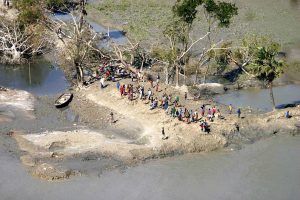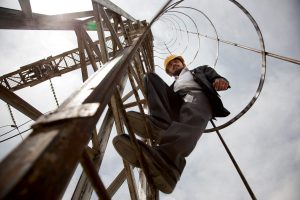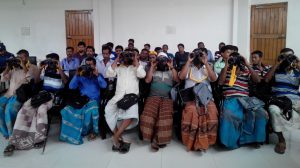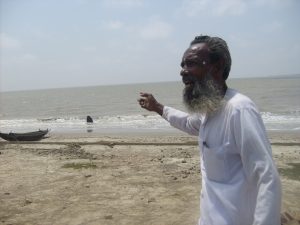Neither the Bay of Guanabara nor the Rodrigo de Freitas Lagoon – two of Rio de Janeiro’s main outdoor Olympic aquatic sports venues – will be totally pollution-free by the time the games begin on August 5, experts have admitted.
However, the international sailing and rowing federations and the Rio authorities promise both sites will be suitable for hosting events. “We have all the conditions to have very good water quality in the Bay of Guanabara,” said Guido Gelli of the Bay of Guanabara Environmental Sanitation Program (PSAM), which is managed by Brazil’s environment ministry.
In the bay’s main channel (where events will take place), conditions are more favourable in the months when rainfall is less frequent, Gelli added. “Together with the Marina da Glória [which has been refurbished to host sailing events], we will take samples every day, everyone will be able to see the analyses,” Gelli said.
A well-known tourist attraction in Rio de Janeiro, the Bay of Guanabara has a surface area of 400 km2, and a long history as a dumping ground for rubbish, industrial runoff, and untreated sewage from informal housing from around 15 municipalities. “I assure you that the water samples will be within international standards,” Edes Fernandes de Oliveira, director of production and overall operations at the Rio Water and Sewage Company, told Diálogo Chino.
After two test events, the International Sailing Federation drafted a report indicating that regattas in the Bay of Guanabara were viable. Athletes from at least 60 countries will compete in sailing events during the Olympics in Rio de Janeiro in two months’ time.
“Water conditions in the Bay of Guanabara could improve,” the Brazilian Sailing Confederation (CBVela) admitted, adding: “CBVela wants this not only for the sport, but also to benefit all Brazilian citizens, especially Rio’s residents.”
In 2009, as part of its candidature to host the Olympics, the Rio government pledged to clear and treat 80% of all sewage by 2016, through the Bay of Guanabara and Barra-Jacarepaguá Cleanup Program. The document signed by João Havelange, who was later removed from the International Olympic Committee (IOC) and the International Football Federation (FIFA) after accusations of corruption, stated that the federal government’s National Plan for Basic Sanitation had secured investments of US$4 billion for restoration programs.
“That number won’t be reached,” said Rogerio Valle, professor of production engineering at Coppe/UFRJ (Federal University of Rio de Janeiro). “This number, 80%, came up because it was thought that the national plan would be completed, but they were imaginary numbers.” Oliveira gives other reasons for the delays: “Many unforeseen events took place and several simultaneous projects are being undertaken in the city. Who knew we’d find an underground port halfway through?” he said.
But Oliveira offered no response when asked by Diálogo Chino if the project had failed to plan for contingencies and missed deadlines. The clean water pledge has now been pushed back to 2018. According to official data, between 2006 and 2010 around 500 million Brazilian reais (US$140 million) were invested in sanitation in Rio de Janeiro state, where only 30% of sewage is treated, up from 20% for the previous period.
It is expected that 10,500 athletes from 206 countries will travel to Rio de Janeiro to compete in the 306 Olympic events across 42 different sports, which will be held over the course of 17 days. Brazilian authorities estimate that more than 300,000 tourists will come to watch the Olympics in 2016.
Long-term project
At least 55 large rivers flow into the Bay of Guanabara after passing through 15 municipalities. The rivers carry domestic sewage and improperly disposed-of waste from almost all the Baixada Fluminense, a region in the north of Rio de Janeiro state.
“Baixada Fluminense’s problem is the bay’s problem. If you deal with the question of sanitation in the Baixada Fluminense, you solve most of the problem,” says professor Valle.
“We are working on sanitation projects in the Baixada Fluminense, with funding from the Inter-American Development Bank (IDB),” said Flavio Silveira, coordinator of the unit within PSAM carrying out the environmental sanitation program around the Bay of Guanabara.
According to PSAM, industrial pollution has been practically resolved: “All industries are within the licensing system, the dumps as well,” Gelli says.
Among the state government’s Olympic projects, PSAM coordinates the implementation of the sewage collection and treatment system in some municipalities, the installation of eco barriers and the use of eco boats. “The short-term solution for the Olympics was to have collection in places where the games will take place. We made the ‘belt gallery’ [a series of gutters surrounding the lagoon] to collect the rivers before they enter the Marina da Glória. We were going to divert the rivers, get them out of there. And we did it,” explains Gelli.
The question of solid waste, such as sofas and other objects that float on the surface, should be a simpler matter.
“Floating solid waste is an easier problem to control, and probably won’t cause any problems during competitions. The whole issue is the quality of the water, which will not be at its worst when the games take place,” Gelli said.
Commenting on the results of an Associated Press (AP) investigation into water quality in the Bay of Guanabara, Oliviera said: “Viruses are one thing, bacteria is another. Viral decontamination of the water was never anticipated. What the IOC requires will be fulfilled.”
AP’s tests detected levels of waterborne viruses 1.7 million times above levels that would be considered ‘alarming’ by Californian beaches. Tides in Guanabara Bay’s main channel replace around half of the bay’s water every 11 days.
Rodrigo de Freitas Lagoon
After being criticised for poor water quality, the Rodrigo de Freitas Lagoon passed tests by the International Rowing Federation (Fisa), which presides over Olympic rowing competitions.
At the end of last year, Fisa issued a statement saying its experts had shown the incidence of diseases to be much lower than when previous rowing events were held in other lagoons worldwide.
Pollution in the lagoon worsens in rainy season, owing to its location in the middle of a densely populated urban area.
According to Oliveira, although waste is not directly dumped into the waters of Rodrigo de Freitas, illegal sewage connections discharge into runoff channels with waste ending up in the lagoon when it rains. Gelli points out that Rio de Janeiro city authorities will monitor and publish daily bulletins on water quality from a control center in Leblon, a neighbourhood adjacent to the lagoon.
Olympic legacy
For Gelli, the Rio games are an opportunity to place urban and social problems at the center of the debate.
“We’re talking about communities that live in very precarious conditions, living in huts in the middle of the river. How are you going to build a sewage collection system in a place like that, that doesn’t even have streets or houses?” he asked.
Gelli said one of the main aims of PSAM is to work together with municipalities around Guanabara Bay to create basic sanitation plans. “My mission here is to provide transparency not only for the water in Guanabara, but also for information.”
Valle added that the city government has also partnered with local universities, to help the state track and monitor water quality. “The idea is to have an independent evaluation,” he said. Despite Brazil’s economic and political crisis, attention is beginning to turn to the upcoming Olympic Games.
“This is what we hope for from this Olympic moment: to promote a long-term change in the city alongside the games. This is the legacy we want.”








